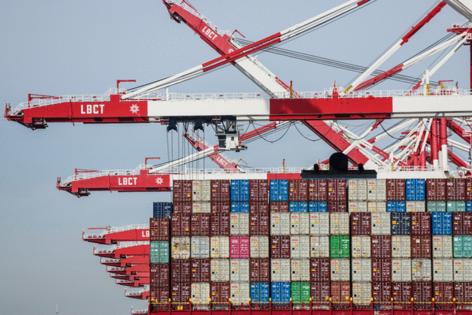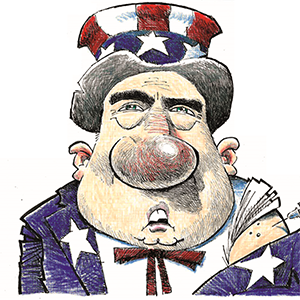US-China truce likely to avert recession but not coming slowdown
Published in News & Features
The Trump administration’s temporary trade deal with China didn’t arrive in time to prevent a slowdown in the U.S. economy, forecasters say, even if it reduces the risk of a full-blown recession later this year.
Labor-market data could start to show the hit to employment by the end of May, they expect, while accelerating inflation should become evident in reports due next month.
That combination leaves the economy on track to grow significantly less this year than in 2024, even after accounting for Monday’s truce. While the current U.S. levy on Chinese imports of 30% is well below the 145% duty put in place over the last month, it still represents a sharp increase from before President Donald Trump took office in January.
“The temporary U.S.-China tariff reprieve is a notable de-escalation, but it won’t avert a slowdown,” said EY Chief Economist Gregory Daco. “Front-loaded demand, elevated price pressures, and acute policy uncertainty will still weigh on hiring and spending.”
Investors cheered announcements Monday by the U.S. and China of the 90-day reduction in tariffs, sending the S&P 500 to the highest levels in more than two months. Financial markets have also received some support in recent weeks from key gauges of economic activity, which have yet to show real signs of weakness despite warnings from forecasters that pain will soon arrive.
Take retail sales, for example: They jumped in March by the most in two years as consumers rushed to pull forward purchases. Meanwhile in the labor market, a monthly jobs report published on May 2 showed employers in transportation and warehousing were still staffing up in the first few weeks of April to handle the surge in demand.
One key question is whether households and businesses will take advantage of the 90-day reprieve announced Monday to do more stocking up. Mark Zandi, the chief economist at Moody’s Analytics, is skeptical. He expects weekly reports on filings for unemployment insurance to start rising by Memorial Day on May 26, foreshadowing a slowdown in hiring that will become clear in the June jobs report.
“There is no change in the outlook. I had expected the administration to soon strike an arrangement with China and other countries, de-escalating the trade war. But the war continues on,” Zandi said. “I would expect the payback for all the forward buying to begin this month, and extend into June and July.”
Trump’s imposition in early April of a 145% tariff on Chinese imports sparked a plunge in container traffic from China to the U.S. — a trip that typically takes 22 days, according to Xeneta, a freight rate benchmarking and market analytics platform. Loading, unloading and distribution adds to the journey.
Gene Seroka, the executive director of the Port of Los Angeles, told the Wall Street Journal on Monday he expects import volumes to end the month down 25% versus a year ago, and like Zandi, he doesn’t see another burst of frontrunning coming either.
Others — like economists at Comerica Bank and Oxford Economics — predicted the opposite: “U.S. importers are likely to ramp up purchases near-term to hedge against tariffs rising again,” Comerica’s chief economist, Bill Adams, said in a note.
Inflation impact
Because of the time it takes for goods to traverse the waterways between Shanghai and California, the brunt of the tariffs has yet to be felt in the U.S. A monthly report on consumer prices for April due Tuesday will probably show inflation was relatively muted last month, but economists expect bigger price hikes to begin showing in earnest in the May report, to be published in mid-June.
“One reaction to a sharp tariff cut for China could be to assume it’s disinflationary. But the reality is more nuanced,” Bloomberg economists led by Anna Wong said Monday in a note previewing the numbers. “A catch-up period for restocking retailers’ inventories may lead to port congestion, and if the items on U.S. store shelves are simply scarce — rather than entirely out of stock — then price increases could be recorded faster.”
Forecasters generally agreed Monday’s announcement points to a better, though still subdued, outlook for the U.S. economy this year. Economists at UBS said the deal “could imply” a 0.4 percentage-point boost to their forecast for a 0.5% increase in gross domestic product in 2025, following 2.5% growth in 2024.
Goldman Sachs economists made a similar upgrade — to 1% for 2025, from 0.5% — and reduced the probability of a recession over the next 12 months to 35%, from 45%.
Federal Reserve officials speaking on Monday also underscored the point that tariffs remain high despite the 90-day reprieve. Fed Governor Adriana Kugler told an audience in Dublin that “they appear likely to generate significant economic effects even if tariffs stay close to the currently announced levels,” and Chicago Fed President Austan Goolsbee made similar remarks in a New York Times interview.
Economists said the central bank’s interest-rate decisions in the coming months will depend on whether the labor-market data worsen faster than the inflation data or vice versa, though monetary policymakers aren’t likely to have much clarity one way or the other by their June 17-18 meeting. Investors pushed their bets on the timing of the next rate cut back to September instead of July, according to futures.
“Everybody’s high-fiving and declaring a victory over this, but I would characterize it as a step down from what was essentially a full-blown trade war,” said Tim Quinlan, a senior economist at Wells Fargo. “The growing pains that you’re apt to experience in the interim, you’re only beginning to feel the cost of those in the economic data.”
(With assistance from Brendan Murray and Mark Niquette.)
©2025 Bloomberg L.P. Visit bloomberg.com. Distributed by Tribune Content Agency, LLC.







Comments